Four-year anniversary in San Gimignano represents a towering achievement in Italian relationships
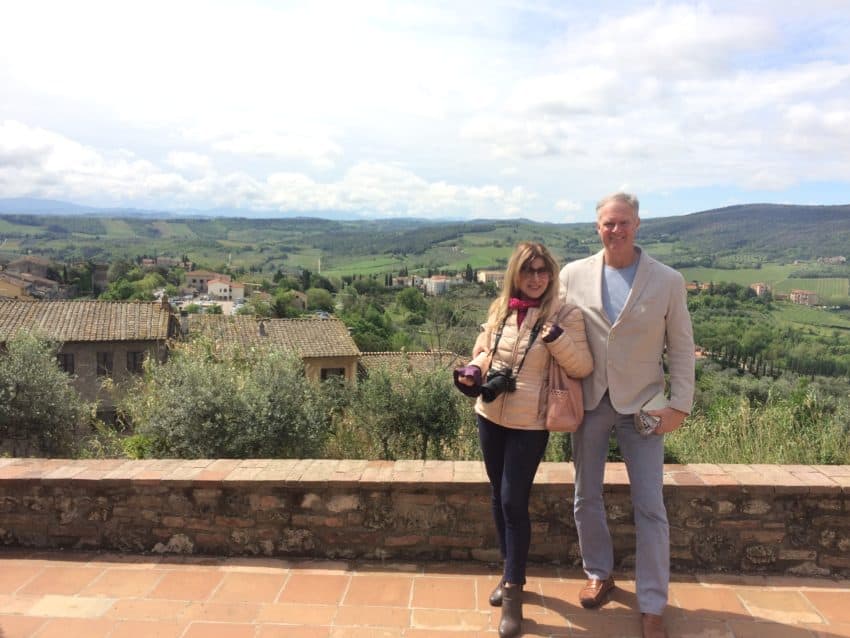
SAN GIMIGNANO, Italy — Relationships in Rome are as hard as the language. You can’t have one without the other. That’s why life in Rome often bounces between passionate kisses near back-lit fountains and sitting alone in a dive bar drinking bottled Peroni. Many women don’t trust the men; many men don’t respect the women. It’s a war of the sexes I’ve chronicled this phenomenon that has been going on since Romeo hit on Juliet on that balcony.
So a relationship lasting four years is worth celebrating. In Rome, it’s almost as rare as fluency for an old American. I’m not fluent yet but Marina and I did pass the four-year mark Monday. As we do every year around April 29, we took a trip, very symbolic since our relationship is built on mutual respect, a love of wildlife and travel.
We took a long weekend to San Gimignano, a quirky little town in Tuscany about 40 miles southwest of Florence. It’s the town of only 7,000 people where 15 stone towers remain from the Medieval Times. That’s back when this part of Tuscany was awash in wealth and locals showed off theirs by building the biggest towers they could. I couldn’t confirm this from the locals, who were quite taken aback by the question, but I believe this is where Americans get the term “penis envy.”
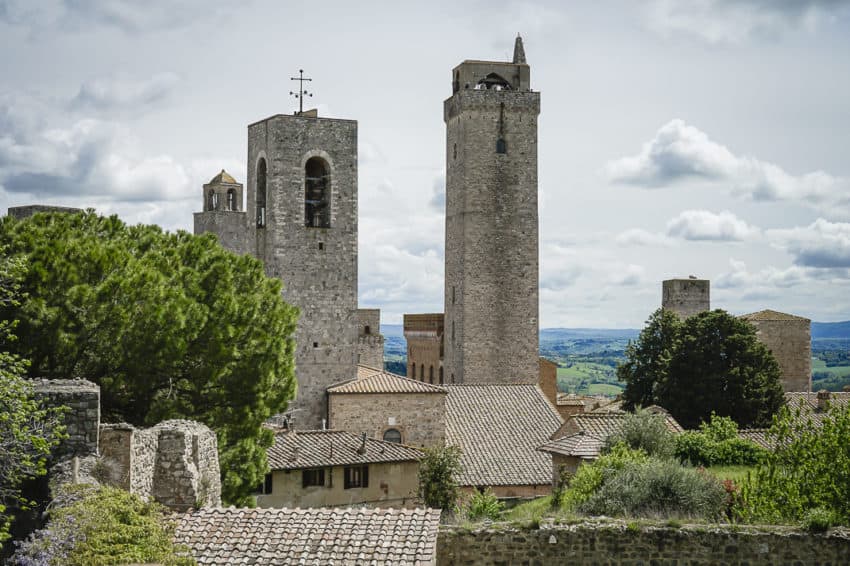
Which brings me back to my original point about the difficult language. How baffling is Italian? Each noun is either feminine or masculine. How do you remember which is which when a word ends in the neutral “e”? You memorize or choose a word association. The Italian word for “tower” is “torre.” It’s feminine, not masculine. Look at the photo of San Gimignano’s skyline and tell me why “torre” isn’t masculine.
Think about it.
I’d been to San Gimignano before. I came five years ago shortly after I first moved to Rome when each new town I discovered was more interesting than the last. San Gimignano’s towers drew me in like a curious cat. The towers stand between five and 10 stories high and can be seen from down in the valley on the connecting bus ride from Siena. As I wrote before, it looks like a giant kid’s Erector set that didn’t quite get completed. These 15 stone sticks stand atop a hill of a tiny town that once was an Etruscan village. Now it looks like a Medieval Manhattan, an itty-bitty Dubai, Shanghai with better wine.
Marina, a third-generation Roman, had never been here before. Since I had, we took a different tact. San Gimignano is not easy to reach. It has no train station. You must take a train or bus 2 hours and 45 minutes to Siena or Florence and get a public bus for a 65-minute ride up the hill. Some buses require a change in Poggibonsi. From Rome to our AirBnB it took eight hours.

However, that didn’t include the one change in my itinerary. We took a long lunch in Siena, Tuscany’s “second city” behind Florence and is the Gothic gem to Florence’s Renaissance. Siena is a city of wildly curving, hilly alleys seemingly all leading to Piazza del Campo, the massive piazza 333 meters in circumference that’s left barren for the hordes of tour groups and locals alike to congregate on warm sunny days.
We came for the lunch recommendation of my good friend, Alessandro Castellani, a Roman totally miscast as a sportswriter instead of an Italian food consultant. In five years, he hasn’t whiffed once and hit a home run out of Tuscany with his nod to La Taverna di San Giuseppe.
Located on a quiet, narrow, cobblestone road, it had a line formed before it opened at noon. The cave-lake restaurant with the vaulted brick ceiling and ham hooks hanging from the ceiling was packed by 12:30. I thought the restaurant, started in 1998, might be a tourist trap when I saw a fat American pass me with a T-shirt reading “WEAKNESSES ARE OVERRATED.”

It wasn’t a tourist trap. I had the short, twisty pasta called trofie, with bits of broccoli and covered in smoked scamorza cheese. It was simply one of the best pastas I’ve had in Italy.
Tuscany has plenty of places to get away from the tourists, but San Gimignano is not one of them. However, we scored a major coup with our AirBnB. Paolo Rubechini’s apartment is located above Piazza Sant’Agostino on the quiet north end of town and around the corner from one of the bus stops. Piazza Sant’Agostino is the quiet respite from the hordes congregating in the adjacent Piazza del Duomo and Piazza della Cisterna in the center of town. Anchored by Chiesa di Sant’Agostino, which depicts the revered saint’s life in 17 frescoes, the piazza is a sprawling space covered in brick.

Our AirBnB, on the upstairs floor of a building adjacent to the piazza, was a 100-square-meter (1,100-square-foot) palace with a big kitchen, long dining room table, two-flat screen TVs (with an English movie channel) and a modern bathroom. It even had a 100-year-old wine press in the living room overlooking the piazza. We stocked the kitchen with fruit, coffee, milk and biscuits from the local supermarket and every morning went to the corner bar or bakery around the corner for fresh cornettos.
No, this was not CouchSurfing in the Third World.
While San Gimignano jars the intrepid traveler’s heightened senses with its choc-a-block souvenir stores, nothing can spoil its incredible views. We walked along the walls past the piazzas and stared out at the Tuscan countryside which is as beautiful as the libraries of literature depict. Rolling green hills, parceled farmland, little villages with brown and red-tiled roofs and small, family vineyards. This is the Tuscany you daydream about sitting at your humming computer.
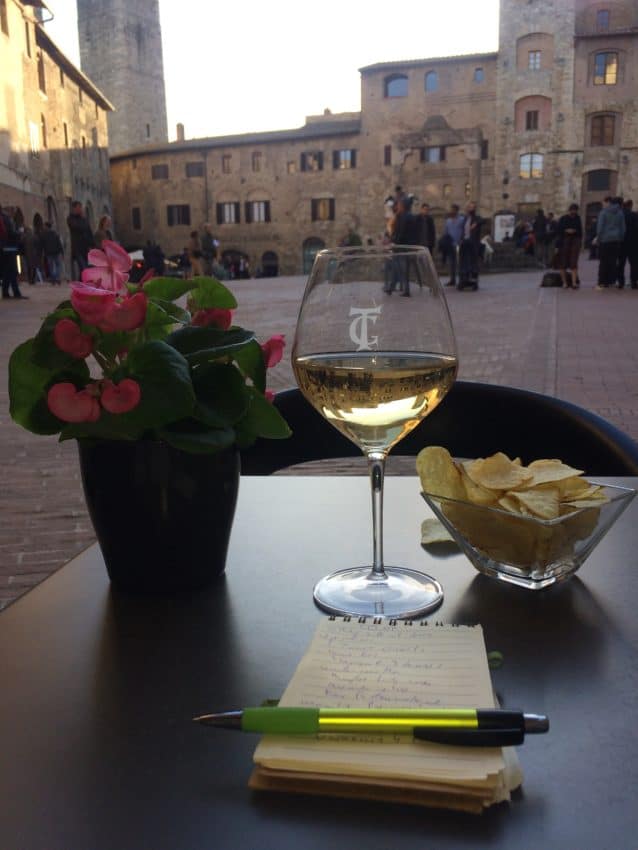
I even like the view from the crowded piazzas. No place else in Italy — not Rome, not Milan, certainly not Florence — can you sit in a piazza and look at towers. In Piazza della Cisterna, which features a well from 1287, we took seats at Torre Guelfa, one of the many outdoor cafes ringing the piazza. With a glass of San Gimignano’s signature Vernaccia white wine, we sat back and looked past the piazza to one of the towers, sticking up like a giant periscope. Dusk had settled in and most of the tourists and gone back to their rooms in Siena and Florence. A chilly breeze swept through. We were in total peace, the harmony of four years and 19 countries together.
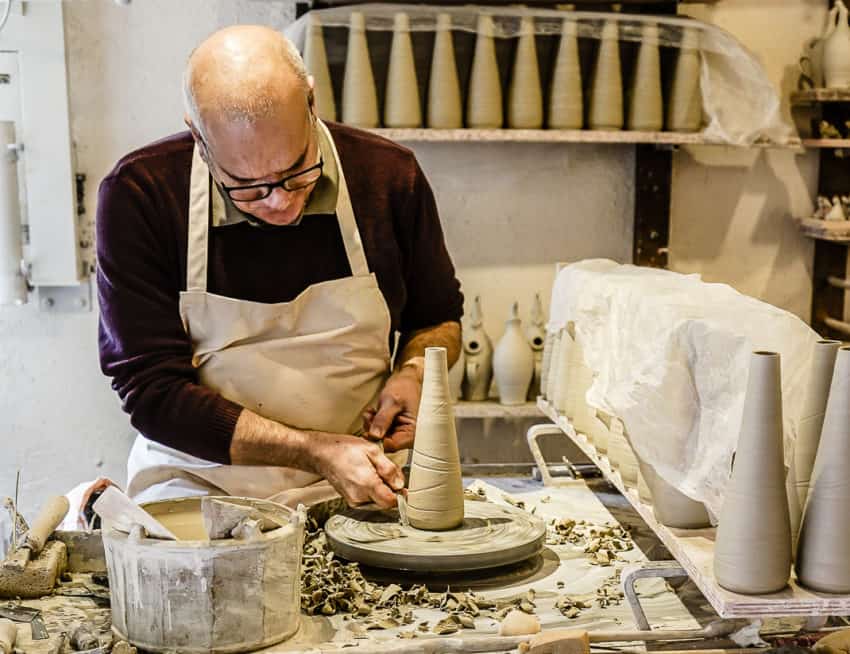
But of all the places we’ve been — from Beirut to Vancouver — what a weird place to live this San Gimignano. The best real estate are 600-year-old towers with maintenance costs that nearly match the rent. Tourists are everywhere year round. You’re living inside a giant wall. I talked to the young waiter, who grew up here and knew as much about my beloved AS Roma as I did. We discussed the goings on of Serie A soccer before turning to life in Tuscany’s novelty of a town.
He said the winters are harsh. San Gimignano sits at 1,000 feet. Opportunities aren’t available for youths and during some winter lulls in tourism, making ends meet is difficult.

“The biggest problem with the influx of many tourists becomes parking and roads,” Paolo wrote me in a message. “Now it seems they are trying to solve this problem with more parking and a ring road.”
Paolo also lives in Florence but was raised in San Gimignano and hasn’t gotten chased out by the tourists as so many Venetians have in Venice.
“My experience of living in the tourist city is very positive,” he wrote. “In addition to increasing the local economy, it also allows a great cultural exchange. The tranquility and safety of the place are the best things as well as the beauty of the places.”

He left out food. San Gimignano has as many good restaurant as any Italian town with 7,000 people. On the piazza is Locanda di Sant’Agostino, run by Paolo’s friend, Genziana, a hip, friendly woman with a packed place nearly every night. Her small restaurant with spacious outdoor seating is kitschy at its best. The walls are covered with framed photos of flowers with tufts of straw and red chandeliers hanging from the ceiling. Soft music fills the air.
I ordered a glass of chilled Vernaccia and a duck leg in orange sauce where the meat fell off the bone. For lunch I took Marina to a favorite haunt, Dal Bertelli, a small, simple sandwich shop where Brunello Bertelli’s family, in San Gimignano since 1779, has been cutting thick slabs of local pecorino cheese and salami on bread for years. The place is filled with old farm equipment on the walls, such as giant pinchers to cut grapes in vineyards.
Two problems with Tuscan cuisine: The bread, without question, is the worst in the world. In 1540 Tuscany began taxing salt, and bakers stopped putting salt into bread. Who knew salt kept bread from having a hint of flavor which is what bread tastes like in every restaurant in Tuscany.

Also, some restaurants get full of themselves. I wanted to take Marina back to Cum Quibus, which was wonderful five years ago. In fact, it was so wonderful it earned a Michelin star. Thus, ravioli I paid 9.50 euros for in 2014 has been replaced with pasta dishes ranging from 32-38 euros. We ditched our reservations and went to Bar Piazzetta on the corner where a bunch of locals gathered for a casual evening. No Michelin stars could be seen but my plate of tagliatelle with Tuscan ragu (wild boar sauce) for 9 euros earned one from me.
In San Gimignano I always develop a small dependency on Vernaccia wine. It has been around since the Renaissance and has been credited to bringing Tuscan wine to the forefront. People practically pour it on their Corn Flakes here. The area in and around the town has 63 wineries and each vineyard has its own distinct Vernaccia taste, ranging from tea to oleander to passion fruit and lychee. (At least, that’s what I read. I sure as hell can’t tell.)
But I did learn some when we spent our getaway day at La Rocca, a winery atop a hill on the edge of town featuring a tasting room with wines on tap and a veranda looking out over the gorgeous countryside. We sat drinking wine and watching Asian tourists shoot photos of the countryside without every looking away from their camera lens.
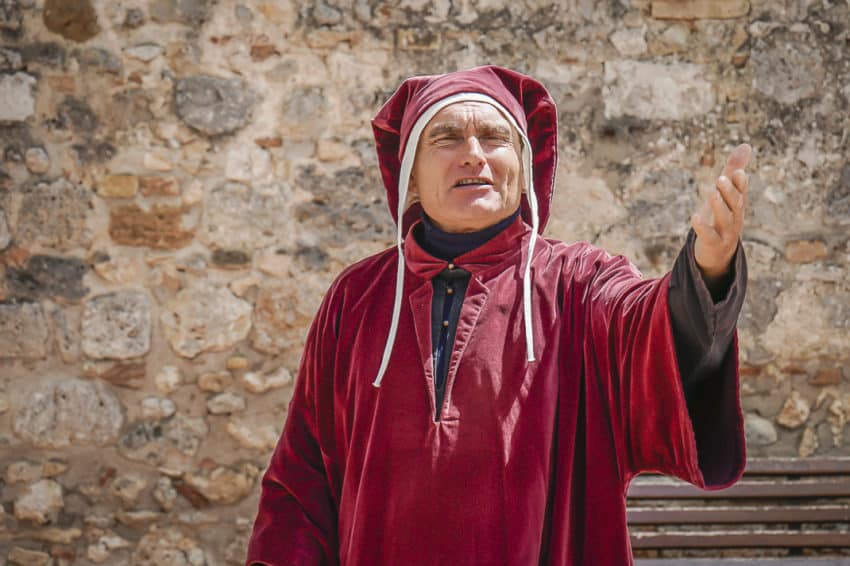
Suddenly we heard a rhythmic chanting from below. We walked over and a man in a medieval maroon and white costume was loudly reciting poetry to the passersby. Giovanni Terreni is a major fan of Dante Alighieri, Tuscany’s prize poet whose prose from his “Divine Comedy” Terreni blared out for all to hear.
One quote particularly caught our interest. It perfectly captures our lives, our travels, our time in this town of towers.
“Tonight we fly over the chimney tops, skylights and slates, looking into all your lives and wondering why happiness is so hard to find.”


May 3, 2019 @ 9:30 pm
Una bella racconta, come sempre, Giovanni.
Voglio vivere la tua vita perche e bellissimo e affascinante! E’ vero.
Visitero’ questo paradiso! Non so quando, ma sono sicuro che l’ho fatto!
Grazie
May 4, 2019 @ 1:01 am
Thanks, Michael. It’s definitely worth seeing. Just book in advance. Got your dates picked out yet?
May 4, 2019 @ 12:53 pm
Happy Anniversary! Here’s to finding happiness! You’re certainly looking in the right places!